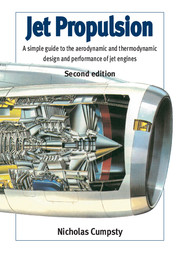 Jet Propulsion
Jet Propulsion Book contents
- Frontmatter
- Contents
- Preface
- Glossary
- Nomenclature
- Part 1 Design of Engines for a New 600-seat Aircraft
- 1 The New Large Aircraft – Requirements and Background
- 2 The Aerodynamics of the Aircraft
- 3 The Creation of Thrust in a Jet Engine
- 4 The Gas Turbine Cycle
- 5 The Principle and Layout of Jet Engines
- 6 Elementary Fluid Mechanics of Compressible Gases
- 7 Selection of Bypass Ratio
- 8 Dynamic Scaling and Dimensional Analysis
- 9 Turbomachinery: Compressors and Turbines
- 10 Overview of the Civil Engine Design
- Part 2 Engine Component Characteristics and Engine Matching
- Part 3 Design of Engines for a New Fighter Aircraft
- Part 4 Return to the Civil Transport Engine
- Appendix: Noise and its Regulation
- Bibliography
- References
- Index
- Design sheets for New Large Civil Aircraft and New Fighter Aircraft
5 - The Principle and Layout of Jet Engines
from Part 1 - Design of Engines for a New 600-seat Aircraft
- Frontmatter
- Contents
- Preface
- Glossary
- Nomenclature
- Part 1 Design of Engines for a New 600-seat Aircraft
- 1 The New Large Aircraft – Requirements and Background
- 2 The Aerodynamics of the Aircraft
- 3 The Creation of Thrust in a Jet Engine
- 4 The Gas Turbine Cycle
- 5 The Principle and Layout of Jet Engines
- 6 Elementary Fluid Mechanics of Compressible Gases
- 7 Selection of Bypass Ratio
- 8 Dynamic Scaling and Dimensional Analysis
- 9 Turbomachinery: Compressors and Turbines
- 10 Overview of the Civil Engine Design
- Part 2 Engine Component Characteristics and Engine Matching
- Part 3 Design of Engines for a New Fighter Aircraft
- Part 4 Return to the Civil Transport Engine
- Appendix: Noise and its Regulation
- Bibliography
- References
- Index
- Design sheets for New Large Civil Aircraft and New Fighter Aircraft
Summary
INTRODUCTION
This chapter looks at the layout of some jet engines, using cross-sectional drawings, beginning with relatively simple ones and leading up to the large engines for one of the most recent aircraft, the Boeing 777. Two concepts are introduced. One is the multi-shaft engine with separate low-pressure and high-pressure spools. The other is the bypass engine in which some, very often most, of the air compressed by the fan bypasses the combustor and turbines.
Any consideration of practical engines must address the temperature limitations on the turbine. The chapter ends with some discussion of cooling technology and of the concept of cooling effectiveness.
THE TURBOJET AND THE TURBOFAN
Figure 5.1 shows a cut-away drawing of a Rolls-Royce Viper engine. This is typical of the simplest form of turbojet engine, which were the norm about 40 years ago, with an axial compressor coupled to an axial turbine, all on the same shaft. (The shaft, the compressor on one end and turbine on the other are sometimes referred to together as a spool.) Even for this very simple engine, which was originally designed to be expendable as a power source for target drones, the drawing is complicated and for more advanced engines such drawings become unhelpful at this small scale. Simplified cross-sections are therefore more satisfactory and these will be shown for more advanced engines. A simplified cross-section is also shown for the Viper in Fig. 5.1, as well as a cartoon showing the major components.
- Type
- Chapter
- Information
- Jet PropulsionA Simple Guide to the Aerodynamic and Thermodynamic Design and Performance of Jet Engines, pp. 47 - 59Publisher: Cambridge University PressPrint publication year: 2003
- 1
- Cited by


